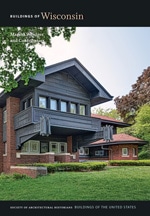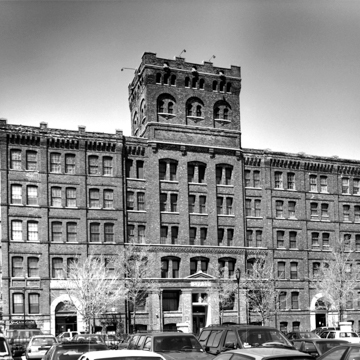Milwaukee’s tanning industry was located along the banks of the Milwaukee River at the base of Brewers’ Hill before the Civil War. Like the brewery district north of Juneau Avenue, the riverside tanneries area also spawned ancillary industries including shoe-makers, saddle makers, and other leather-manufacturing firms. Milwaukee’s leather industry declined in the twentieth century as automobiles replaced horses, and synthetic materials replaced leather for shoes and other products. But the Mayer Boot and Shoe Company factory still stands in Brewers’ Hill. The oldest part of the Mayer complex facing E. Pleasant Street is U-shaped and was built in three stages in 1892, 1895, and 1899. This section’s main (south) elevation is unusually well detailed for a factory facade. The central entrance is framed with brick pilasters terminating in stone capitals, supporting a brick entablature, and a stone-trimmed pediment. The eight-story tower has round-arched windows, corbeling, and a castellated parapet. At its peak around 1910, this factory turned out 9,000 pairs of shoes a day; it closed in 1938. Various businesses later occupied the building.
You are here
F. Mayer Boot and Shoe Company
If SAH Archipedia has been useful to you, please consider supporting it.
SAH Archipedia tells the story of the United States through its buildings, landscapes, and cities. This freely available resource empowers the public with authoritative knowledge that deepens their understanding and appreciation of the built environment. But the Society of Architectural Historians, which created SAH Archipedia with University of Virginia Press, needs your support to maintain the high-caliber research, writing, photography, cartography, editing, design, and programming that make SAH Archipedia a trusted online resource available to all who value the history of place, heritage tourism, and learning.















